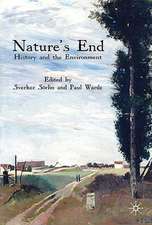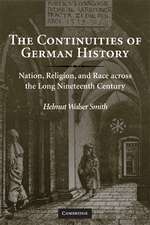Oral History and Digital Humanities: Voice, Access, and Engagement: Palgrave Studies in Oral History
Autor Douglas A. Boyd Editat de M. Larsonen Limba Engleză Paperback – 17 dec 2014
| Toate formatele și edițiile | Preț | Express |
|---|---|---|
| Paperback (1) | 383.93 lei 43-57 zile | |
| Palgrave Macmillan US – 17 dec 2014 | 383.93 lei 43-57 zile | |
| Hardback (1) | 389.70 lei 43-57 zile | |
| Palgrave Macmillan US – 17 dec 2014 | 389.70 lei 43-57 zile |
Din seria Palgrave Studies in Oral History
-
 Preț: 252.67 lei
Preț: 252.67 lei -
 Preț: 399.12 lei
Preț: 399.12 lei -
 Preț: 215.11 lei
Preț: 215.11 lei - 18%
 Preț: 732.40 lei
Preț: 732.40 lei - 15%
 Preț: 642.68 lei
Preț: 642.68 lei -
 Preț: 391.61 lei
Preț: 391.61 lei -
 Preț: 383.93 lei
Preț: 383.93 lei - 15%
 Preț: 646.11 lei
Preț: 646.11 lei -
 Preț: 388.72 lei
Preț: 388.72 lei -
 Preț: 391.61 lei
Preț: 391.61 lei -
 Preț: 216.48 lei
Preț: 216.48 lei -
 Preț: 317.52 lei
Preț: 317.52 lei -
 Preț: 389.11 lei
Preț: 389.11 lei -
 Preț: 383.12 lei
Preț: 383.12 lei -
 Preț: 215.33 lei
Preț: 215.33 lei -
 Preț: 213.05 lei
Preț: 213.05 lei -
 Preț: 381.81 lei
Preț: 381.81 lei -
 Preț: 391.61 lei
Preț: 391.61 lei -
 Preț: 199.37 lei
Preț: 199.37 lei -
 Preț: 389.70 lei
Preț: 389.70 lei -
 Preț: 215.54 lei
Preț: 215.54 lei -
 Preț: 390.63 lei
Preț: 390.63 lei -
 Preț: 393.52 lei
Preț: 393.52 lei -
 Preț: 216.30 lei
Preț: 216.30 lei -
 Preț: 384.09 lei
Preț: 384.09 lei -
 Preț: 201.06 lei
Preț: 201.06 lei -
 Preț: 390.63 lei
Preț: 390.63 lei -
 Preț: 389.70 lei
Preț: 389.70 lei -
 Preț: 213.58 lei
Preț: 213.58 lei -
 Preț: 430.79 lei
Preț: 430.79 lei - 8%
 Preț: 535.97 lei
Preț: 535.97 lei - 15%
 Preț: 645.79 lei
Preț: 645.79 lei - 15%
 Preț: 592.44 lei
Preț: 592.44 lei - 15%
 Preț: 476.75 lei
Preț: 476.75 lei -
 Preț: 386.39 lei
Preț: 386.39 lei -
 Preț: 388.72 lei
Preț: 388.72 lei -
 Preț: 220.93 lei
Preț: 220.93 lei -
 Preț: 388.72 lei
Preț: 388.72 lei
Preț: 383.93 lei
Nou
Puncte Express: 576
Preț estimativ în valută:
73.47€ • 76.90$ • 61.15£
73.47€ • 76.90$ • 61.15£
Carte tipărită la comandă
Livrare economică 31 martie-14 aprilie
Preluare comenzi: 021 569.72.76
Specificații
ISBN-13: 9781137322012
ISBN-10: 1137322012
Pagini: 205
Ilustrații: XVII, 205 p.
Dimensiuni: 155 x 235 x 18 mm
Greutate: 0.32 kg
Ediția:2014
Editura: Palgrave Macmillan US
Colecția Palgrave Macmillan
Seria Palgrave Studies in Oral History
Locul publicării:New York, United States
ISBN-10: 1137322012
Pagini: 205
Ilustrații: XVII, 205 p.
Dimensiuni: 155 x 235 x 18 mm
Greutate: 0.32 kg
Ediția:2014
Editura: Palgrave Macmillan US
Colecția Palgrave Macmillan
Seria Palgrave Studies in Oral History
Locul publicării:New York, United States
Cuprins
Introduction – Douglas A. Boyd and Mary A. Larson Part I - Orality/Aurality Chapter 1: "Oral History in the Age of Digital Possibilities" by William Schneider Chapter 2: "WHY DO WE CALL IT ORAL HISTORY? Refocusing on Orality/Aurality in the Digital Age" by Sherna Berger Gluck Chapter 3: "Adventures in Sound: Aural History, the Digital Revolution, and the Making of I Can Almost See the Lights of Home: A Field Trip to Harlan County Kentucky" by Charles Hardy III Chapter 4: "'I Just Want to Click on it to Listen': Oral History Archives, Orality and Usability" by Douglas A. Boyd Part II –Discovery and Discourse Chapter 5: "Beyond the Transcript: Oral History as Pedagogy" by Marjorie McLellan Chapter 6: "Notes from the Field: Digital History and Oral History" by Gerald Zahavi Chapter 7: "Densho: The Japanese American Legacy Project" by Tom Ikeda Chapter 8: "Deconstruction without Destruction: Creating Metadata for Oral History in a Digital World" by Elinor Mazé Chapter 9: "'We All Begin with a Story': Discovery and Discourse in the Digital Realm" by Mary A. Larson Part III - Oral History and Digital Humanities Perspectives Chapter 10: "Swimming in the Exaflood: Oral History as Information in the Digital Age" by Stephen Sloan Chapter 11: "[o]ral [h]istory and the [d]igital [h]umanities" by Dean Rehberger
Notă biografică
William Schneider, University of Alaska Fairbanks, USASherna Berger Gluck, California State University Long Beach, USACharles Hardy III, West Chester University, USAGerald Zahavi, SUNY Albany, USAMarjorie McLellan, Wright State University, USATom Ikeda, Densho Project, USADean Rehberger, Michigan State University, USAElinor Mazé, Baylor University, USAStephen Sloan, Baylor University, USA
Caracteristici
Boyd and Larson are key figures within the oral history community Contributors to the volume include some of the best-known scholars within the oral history world, including Gerald Zahavi, Sherna Gluck, and Charlie Hardy By covering the evolution of the field up to today, this volume takes a different tack to other books available, by distilling the broader concepts of how oral historians can best engage with technological change.












